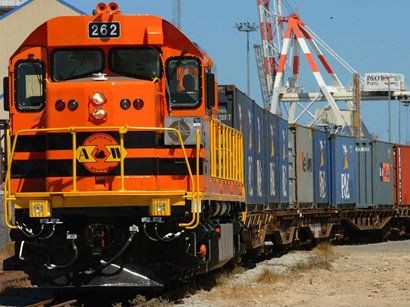LONDON (TCA) — The dream of operating a railways system from China to Europe via Kyrgyzstan and Uzbekistan seems to have taken a detour since the present situation shows that with the exception of Kazakhstan, the other Central-Asian post-Soviet republics find themselves on the losing end of China’s rail expansion scheme – due to various “realities”.
The railway map of the southern parts of Central Asia as it looked by the turn of the century mainly struck attention by the multitude of gaps and dead-ends. There were no coherent national networks in Turkmenistan, Uzbekistan, Tajikistan or Kyrgyzstan. Only recently Tashkent was linked to the isolated but densely populated Fergana Valley in the east, which thus far could only be reached by rail crossing Tajik territory. But the Uzbek part of the Fergana valley remains a dead-end in itself: three tracks run into Kyrgyzstan but end just across the border.
The only railway to speak of in Kyrgyzstan comes from Kazakhstan and goes via Bishkek to Balykchi on the west point of Lake Issyk-Kul. Tajikistan is the most isolated place of them all: there is a small network in the northwest and another one in the southwest, but both of them end up in Uzbekistan. Both Uzbekistan and Turkmenistan lack national east-west connections except a single one which they share, causing delays and hassles at border points making them economically non-viable. For all four republics, China remains out of reach for trains.
Revival of ancient Silk Road
In Central Asia the revival of the ancient Silk Road, as part of China’s new policy to connect Europe to China, at the moment sees in the forefront only Kazakhstan that is now the only place with some progress on the ground.
In November 2014, a cargo train departing from eastern Chinese city of Yiwu, loaded with 82 containers with a final destination of Spain, travelled 13,000 kilometres in less than 27 days. The Chinese train crossed Kazakhstan, Russia, Belarus, Poland, Germany, France and finally reached Madrid in Spain.
Recently a long-distance cargo train loaded with 32 containers travelled from China to Iran covering approximately 10,000 Kilometres via Kazakhstan and Turkmenistan, reaching the port of Bandar Abbas in Iran.
Exportation outlet bottlenecks
Also in Kazakhstan, a 214 km south–north line from Shubarkol to Arkalyk was opened, linking central Kazakhstan to Russia and thence western Europe, thereby offering a shortcut of about 1,000 kilometres to trains from China. It completed the planned track from the south-Chinese industrial centre of Harbin to Yekaterinburg in the southern Urals. In February, the first train transported $1.46 million in bicycle parts and light industrial products from mostly southern China, the Chinese state news agency Xinhua reported.
China’s fast-growing industries and limited internal markets have caused exportation outlet bottlenecks for quite some time. “The demand for faster rail transport over the vast Eurasian distances is clear. China’s container port activity and that of its European and North American destinations is reaching a saturation point as volumes of container traffic explode at double-digit rates,” a recent comment by the American geopolitical expert William Engdahl (known for his sharply critical position on US overseas policy) was to read. “The growth rate for container port throughput in China in 2006, before outbreak of the world financial crisis, was some 25% annually. In 2007 Chinese ports accounted for some 28 per cent of world container port throughput.”
‘Successfully tested’
Kazakhstan and Russia are the main competitors of the rest of Central Asia where transit trade from China is concerned. “The First Eurasian Land Bridge runs through Russia along the Trans-Siberian Railway, also called the Northern East-West Corridor, from the Russian Far East Port of Vladivostok and links in Europe to the Port of Rotterdam some 13,000 kilometre,” Engdahl notes – adding that unless upgraded, the link which allows no high-speed traffic may lose against its competition. “In January 2008 a long distance Eurasian rail freight service, the Beijing-Hamburg Container Express, was successfully tested by the German railway Deutsche Bahn. It completed the 10,000 km journey in 15 days to link the Chinese capital to the German port city, going through Mongolia, the Russian Federation, Belarus and Poland.”
‘Current economic realities’
But recent economic figures bring bad tidings. “Through the year 2015, Russia’s trade with China dropped to $63.5 billion, or 28% down year-on-year, mainly due to adverse market conditions and declining energy prices,” according to a recent report in the Asia Times. “In 2011, Moscow had pledged to increase the bilateral trade turnover up to $100 billion/year in 2015 and $200 billion/year in 2020. However, these pledges appeared to be detached from the current economic realities.”
China “eliminated” 91 million tonnes of outdated capacity in the iron industry and 94.8 million tonnes in the steel industry from 2011 to 2015, according to a report by Tass posted in January this year referring to the Chinese Industry and Information Technology Minister Miao Wei. For the cement industry, the capacity cut was 640 million tonnes, while the aluminum sector saw a reduction of 2 million tonnes. And there is more on the way. Thus, China’s crude steel production capacity will be slashed by 100 million tonnes to 150 million tonnes over the next five years. All this puts constraints on the need for export transportation facilities – and what is available today may well be all that is needed for some time to come.

